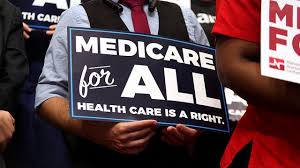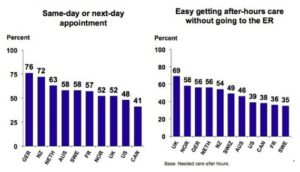
Six months ago, the nation was embroiled in a contentious midterm election cycle. Now, many major characters in the running for the Democratic nomination in 2020 have already begun their campaigns. Just like in 2016 with the Republican Party, the Democratic primary is filled with more than a dozen candidates. In light of the overwhelming decisions voters will have to make in choosing between many different candidates, many people will be trying to figure out how to isolate their favorite. One very important litmus test for the Democratic primary contenders will definitely be health care, an issue that concerns a hefty majority of the country and is central to the party’s platform.
In this election cycle, more and more voters care about Medicare for All; in other words, a single-payer health insurance system, as opposed to our current system that allows private insurance companies to control health insurance. Under a single-payer system, every single American would have an insurance card to prove that they’re covered. This would replace households paying a private insurance company premiums, deductibles, and copayments in order to get coverage. It ensures that every single citizen would be covered no matter what, and coverage would be expanded to include each of the following:
- Inpatient and outpatient health care services
- Preventative, emergency, and nonemergency health care services
- Primary and specialty health care
- Care for vision, hearing, and oral health
- Mental health and addiction services
- Prescription medication
- Medical equipment and supplies
- Diagnostic tests
Medicare for All has recently polled at a whopping 70% among voters overall, including 52% of Republican voters. While the numbers may vary as debates about single-payer health insurance continue, this indicates the majority of voters are unhappy with the current health insurance system and want to change it. In this article, I want to examine the current problem with our health insurance system, explain how Medicare for All will provide a solution for those issues while dispelling common myths about it, and finally put the issue into context—especially in terms of what we learn at Jesuit, because there are multiple different perspectives that are important in talking about providing health care for all.
The Problem
For a while, politicians have been re-stating the obvious: there’s a massive health care crisis in America right now. However, it’s important to take a look at the real impact that has on a large portion of US citizens. At least 29 million Americans are uninsured, and millions more are under-insured and are stuck with burdensome health care costs. The data shows that in 2013 alone, 56 million people struggled to afford the costs of health care. Unfortunately, despite the sweeping promises of the Affordable Care Act to “solve” health care, many people are still stuck in difficult financial situations despite having some form of care.
Perhaps the largest issue with rising health care costs isn’t just the “health” aspect, but also the crushing effects on the ability of American families to keep up with the cost of living. For instance, medical bills cause people to take out loans, skip out on groceries, clothing, or rent, which can endanger their survival. In some instances, it also means that people choose to postpone care because they fear high costs. Imagine if someone didn’t have the money to get a routine check-up at their physician’s office. That could cause serious underlying conditions to go unnoticed until they spiral out of control. This ends up sending people directly to the hospital, where it may be too late, and the bills become much more expensive, with added emergency care and drug costs. In the worst-case scenario, health insurance costs, prescription drug prices, and medical bills can lead to bankruptcy. In fact, health-care related services are a major cause of bankruptcy, affecting 1 million people in 2015.
Most stunning, however, is the fact that health care doesn’t only impact the poor and marginalized in this country. On the contrary, many of the people affected are considered “the middle class.” Of the population that struggled to pay their medical bills, two-thirds were homeowners and three-fifths had a college degree. Even worse is that studies now show that medical expenses push 7 million people who make above 150% of the poverty line into extreme poverty. All of these figures show that our health care problem, if left untreated, can fling well-off families into the ranks of poverty and ultimately threaten people’s survival.
Dispelling Myths About “Medicare for All”
As I explained above, Medicare for All essentially changes our national health-care system into a single-payer health care system and expand coverage to fit a wide range of health care needs. Here are some common talking points that are used against Bernie Sanders’ plan that I want to break down:
“How are we going to pay for it?”
This is the most popular but also most cliché response to Medicare for All. However, before I actually explain the ways in which the United States can pay for this plan, I want to point out the problem with this question. Many people who argue against Medicare for All are the same exact people that argue in favor of policies that increase the deficit, such as Trump’s Tax Cuts and Jobs Act, Trump’s recent increase to the military budget, and the cumulative spending on unsuccessful foreign military interventions. Trump’s tax cuts will increase the federal deficit by $1 trillion over the next decade. Of the people against Medicare for All, who asked Trump, “how are we going to pay for the tax cuts?” Trump has added $200 billion in spending to the military budget from 2017-2019. Who responded by asking him, “how are we going to pay for it?” Furthermore, the United States spending on wars in the past two decades reached a whopping $5.6 trillion in 2018 and it cost each taxpayer $23,386. Evidently, we’ve paid large sums of money for policies that affect the top 1% of the country and our military power, but are we not allowed to spend money on the other 99% of Americans who need it more?
Unlike the expensive policies I mentioned above, Medicare for All actually saves money. The Mercatus Institute, a libertarian-funded think tank that set out to display how Medicare for All would cost way too much, actually came back to find that it saves $2 trillion. This is because the United States already spends trillions of dollars on health care coverage, including the federal government, states, citizens, businesses, etc. Shortly after this study came out, the Political Economy Research Institute (PERI) found that single-payer would save $5.1 trillion, and that added benefits like increased workforce productivity, greater income inequality, and job creation through lowering costs for small and mid-sized businesses would boost GDP.
“But Bernie’s plan would tax the working class”
Correct. But what many people who claim this don’t tell you is that families would net save money. This is simply because the tax increases under Bernie’s plan are cheaper for most families than premiums, deductibles, and copays as well as other health care bills and drug costs. Additionally, there are feasible ways to pay for this new system. First, you could have a 7.5% income-based premium paid by employers, which raises $3.9 trillion and would be $9000 cheaper for businesses, since they wouldn’t have to pay for private insurance companies to cover their employees. Second, you can have a 4% income tax for health care paid by households, which is a very small amount of money, saving an average middle-class family $4,400 and providing them coverage. Both of these prove that you can provide money for Medicare for All without hurting working families and middle-income families.
“It would make the wealthy pay more than their fair share”
Actually, it would just make the wealthy pay exactly their fair share, and fears that taxes on the wealthy would be absurd are blown out of proportion. Another one of the ways in which you can pay for single-payer, according to the same source I cited above, is to institute a progressive marginal tax system for the wealthy, which would raise $1.8 trillion in a decade. Marginal taxes can be misleading because it seems like a 40% marginal tax rate on income of $250,000 to $500,000 would take 40% of that money. However, if someone made $300,000, they would only get the 40% tax on the $50,000 above $250,000, which means they would still walk away with $280,000. Not bad!
Additionally, many wealthy corporations don’t pay their fair share of taxes. IBM, JetBlue, Deere, Delta Airlines, Netflix, and Amazon paid negative tax rates in 2018, which is absurd, as they could’ve alone contributed billions of dollars towards paying for universal health coverage. Simply eliminating unfair tax breaks received by the wealthy would pay for a great portion of Medicare for All without disproportionately targeting the rich. The goal isn’t to demonize the rich, but rather to create accountability and a tax system that makes sense so that the rest of the country can at least meet their basic needs; in this case, health coverage.
“But people would have to leave their current plans”
I think Bernie really explained this one well when he went on Fox News for a town hall a couple of weeks ago. He argued that many Americans don’t have a stable plan right now, because it’s largely employer-based. Whenever someone loses a job, switches jobs, or has an employer that decides to switch providers, they already don’t have much choice over their provider. That doesn’t even account for the millions of people without any coverage to begin with so having insurance in the first place would be a step in the right direction for them.
However, people aren’t in love with their private insurance plans. Why would they, when they’re still left uninsured and struggling to pay their bills, which include high premiums, deductibles, and copays? Insurance companies aren’t the friendly faces that people interact with when they’re going to receive care; doctors and hospitals are. Doctors and hospitals won’t go anywhere under Medicare for All. In the same town hall that I mentioned above, the hosts asked the audience if they were willing to switch away from their private insurance providers. Most of the people in the crowd raised their hands.
“It would hurt doctors”
No, it wouldn’t. As I explained above, doctors and hospitals wouldn’t really suffer because Medicare for All can be paid for. In addition, if you got rid of private health insurance companies, it’s not as if hospitals would stop earning revenue. Studies show that many hospitals would be reimbursed for Medicare more than in the status quo, and even other hospitals would be able to absorb the costs as Sanders proposed a transition period for providers to adjust. In addition, the plan would lower costs for lots of hospitals because it would get rid of paperwork that is required to deal with private insurance companies. A majority of doctors also support Medicare for All, as it means they would be focused more heavily on patients instead of various negotiation tasks with insurance companies.
To be clear, the point of Medicare for All isn’t to line the pockets of for-profit hospitals and practices. Some providers would still have to incur costs and experience a temporary shake-up of coverage plans. However, as polls show, many have warmed up to the idea, and it’s important to think about the big picture. Should we really be prioritizing the desires of those who currently profit from the health insurance industry over the basic needs of millions of Americans who struggle to get by?
“Other countries have had negative experiences with single-payer”

The most cited problem with other countries’ health insurance systems is long wait times. However, long wait times are specific to additional problems with other countries’ health care systems, not necessarily a side effect of single-payer insurance. Canada, who is blamed by many opponents of Medicare for All for having excessively long wait times, doesn’t have the same exact system as the single-payer one proposed by Bernie Sanders but one that is similar in many aspects. In addition, the issue of wait times is blown out of proportion. Most patients in Canada are able to get care within a reasonable time-frame, and emergency care is prioritized. Plus, studies show that the current US system is worse in wait times (see the graphs above). For instance, despite the fact that the US spends more on health insurance than other countries with a single-payer system, the US is ranked toward the bottom in the percentage of patients who claim to get a same-day or next-day appointment and are able to get access to after-hours care.
Even if there were to be some imperfections from health care, the US is lagging behind other countries in health care. Despite what any anecdote may tell you about Canada’s “nightmarish system,” life expectancy is still greater than in the US, according to the World Health Organization. Furthermore, the Commonwealth Fund put out a study in 2017 with 11 developed countries and found that the US ranks dead last overall, as well as in the categories of access, equity, and health care outcomes. That’s pretty telling about how countries with a system similar to “Medicare for All” perform versus our broken private system, even though we outspend all other developed countries.
In Conclusion
Here are a couple of key takeaways from the article:
1) Health care should be a human right. There doesn’t need to be a word about it written in the Constitution; as humans, we should be able to recognize that people should have the right to life. It tells you something about our country when we’re lagging behind the developed world in providing health care—about how much we care for human rights, and how much we care about freedom, liberty, and happiness.
2) It’s interesting how many people take a “pro-life” stance when it comes to abortion, or ending the opioid crisis, or intervening to preserve human rights and democracy in other nations, or being tough on crime to protect their families from harm. It’s even more interesting how those same people believe that universal health care coverage, which would increase the safety and quality of life for millions, isn’t worth it.
3) The Overton window on health care has shifted so far towards the right that people forget how important basic health care is; meanwhile the debate is between almost no government health care and a privatized solution that barely goes halfway in solving the problems our people face. The free market shouldn’t be an option anymore when it comes to health care, because time and time again, it has failed. Medicare for All isn’t radical at all. We already spend trillions of dollars on privatized health insurance in the status quo. Other countries are out-performing us with a similar plan. There’s only a risk that it is more efficient while providing for the needs of millions, as I showed above. Conversely, the system we have now is radical—we call ourselves one of the greatest countries in the world, yet we allow many of our citizens to die or barely get by. This isn’t how it has to be.
4) Finally, I want you to consider this issue from the perspective of a Jesuit student, faculty member, administrator, or alum. We’re taught to be loving. We’re taught to be open to growth. We’re taught to be committed to working for social justice. Health care as a human right obviously embodies those three tenets. There may not be a consensus that Medicare for All is the best solution, but this is what the starting point should be when discussing health care policy, not the other way around. Sometimes, when we begin with advocating for the most “radical” position in terms of striving for basic human dignity, we just might end up getting what’s best for the greater good.





